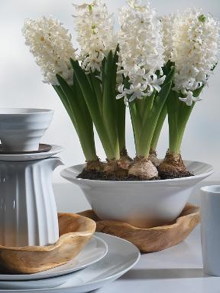Forcing Bulbs for Indoor Winter Blooms

While paperwhites and amaryllis arrive ready to grow, all other bulbs must be chilled before planting indoors for winter blooms. This cooling process, called “forcing,” mimics winter dormancy and coaxes the bulbs to bloom indoors.
Planting: Choose a pot or bowl shallow and wide enough to hold several bulbs. Place a layer of stones or other coarse material in the bottom of the pot, set the bulbs in roots down, then fill the container with fine stones, sand, or light potting mix until the bulbs are about two-thirds covered. Soil that is too rich may cause the bulbs to rot. Water up to the base of the bulbs. You can also use a hyacinth glass: Fill with water to the base of the bulb, and do not let it get dry.
Cooling: After watering, cover the pot with plastic, punch a few holes for air circulation, and place in a dark place at 35–40°, like a garage, unheated basement, or root cellar. If you must put them in your fridge, keep them away from fruit! You can also put them outdoors, covered with 6–8" of mulch. Do not let them freeze or heat up.
Blooming: When leaf tips begin to emerge, set your pot in a cool place with plenty of indirect light. Do not place near a heat source; 50–65° is perfect. Keep the soil moist, but do not overwater. When 3–5" of leaf growth has appeared, bring the pots into direct light to encourage flowering. Once blooms have appeared, remove pots from direct sun to keep blooms from fading quickly.
Springtime: Save the bulbs and plant them in the garden in spring, or let them go dormant in their pots and plant them in fall. They will not force well a second time.
Guide to Forcing Bulbs Indoors
| Bulb Genus | weeks of cooling (35–40°) | weeks of indirect light (50–65°) |
|---|---|---|
| Grecian Windflower, Crocus, Glory-of-the-Snow, Snowdrops, Summer Snowflakes, Squill | 8-12 | 1-3 |
| Iris reticulata, Grape Hyacinths, short Narcissus | 10-14 | 2-3 |
| Hyacinthus, tall Narcissus, Tulipa | 12-16 | 2-4 |
